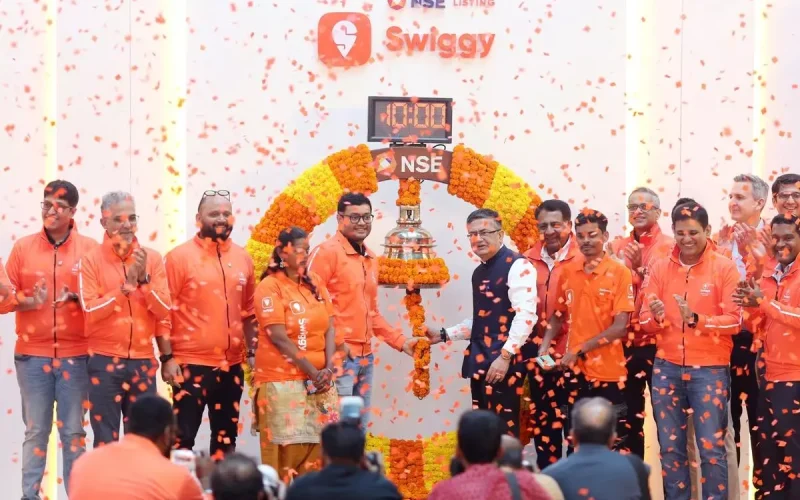Swiggy Delivers 17% Surge in Stock on IPO Debut: A Look at India’s Thriving Food Delivery Market
In a remarkable debut, Swiggy, one of India’s leading food delivery platforms, surged by 17% on its first day of trading, signaling strong investor confidence in the rapidly expanding digital food and grocery delivery market in India. The long-anticipated IPO of Swiggy, backed by prominent investors like SoftBank, Prosus Ventures, and Accel, not only underscored the booming appetite for online services in India but also marked a milestone in the country’s digital economy. Here, we delve into Swiggy’s successful listing, the market dynamics driving its growth, and what this IPO could mean for the future of India’s tech sector.
A Successful Debut: Swiggy’s 17% Market Surge
On its first day of trading, Swiggy’s shares closed with a 17% increase from its initial offering price, generating excitement among retail and institutional investors alike. The IPO was oversubscribed, demonstrating high demand and reinforcing the market’s belief in Swiggy’s business model. The strong performance is seen as a validation of the company’s ambitious expansion strategy, which has helped it capture significant market share in a competitive environment. Swiggy’s decision to list comes at a time when India’s digital economy is thriving, with an ever-increasing number of consumers relying on online platforms for their daily needs.
Swiggy set its offering price at a level aimed to attract both domestic and international investors, pricing it competitively in comparison to its biggest rival, Zomato. The proceeds from the IPO are expected to be used for further expansion, technology upgrades, and a push into new markets. For the fiscal year, Swiggy has projected robust growth, aiming to capitalize on an expanding customer base and an increased adoption of digital payments.

The Road to IPO: Swiggy’s Strategic Moves
Swiggy was founded in 2014 and has since transformed the food delivery landscape in India. Initially focusing solely on food delivery, the company expanded into groceries with its Swiggy Instamart offering and broadened its logistics services with Swiggy Genie, providing parcel and courier solutions. These diversified services have enabled Swiggy to grow its footprint beyond just food delivery and enter adjacent sectors that have substantial growth potential in India’s growing e-commerce market.
The COVID-19 pandemic provided a boost to Swiggy, as lockdowns accelerated the demand for delivery services. During this period, Swiggy not only strengthened its core food delivery business but also ramped up its Instamart grocery delivery platform, which has since become one of its fastest-growing verticals. The increased reliance on online services during the pandemic laid a strong foundation for Swiggy’s long-term growth, pushing it closer to profitability and making it an attractive candidate for public listing.
Key Drivers Behind Swiggy’s Growth
Several factors have contributed to Swiggy’s growth and its favorable reception in the stock market:
-
Growing Appetite for Convenience: With a young, tech-savvy population, India has witnessed a cultural shift towards convenience and on-demand services. Swiggy has capitalized on this trend by offering a seamless user experience, attractive discounts, and a wide range of restaurants, catering to various tastes and preferences.
-
Digital Payments and Fintech Growth: India’s digital payments ecosystem has seen exponential growth, fueled by government initiatives, smartphone penetration, and the adoption of UPI (Unified Payments Interface). This has made it easier for consumers to transact on platforms like Swiggy, which has further accelerated adoption.
-
Increased Affordability: Swiggy has effectively tapped into both urban and semi-urban areas, leveraging competitive pricing, subscription plans, and loyalty programs. Through initiatives like Swiggy Super and Swiggy One, customers receive benefits such as free delivery and discounts, making it a more affordable option for regular users.
-
Investment in Technology and Logistics: Swiggy has made significant investments in its delivery infrastructure and logistics, enabling faster delivery times and enhanced customer satisfaction. The company’s advanced algorithms for route optimization and order batching have played a crucial role in reducing delivery times and operational costs, increasing efficiency across the board.

A Glance at the Competitive Landscape
Swiggy’s IPO debut comes amid a highly competitive market, primarily dominated by Swiggy and its rival, Zomato. With both companies heavily investing in customer acquisition and retention, the competitive landscape has led to market consolidation, with smaller players exiting or being acquired. Unlike Zomato, which focuses predominantly on food delivery, Swiggy has diversified its offerings to include grocery delivery and other services, giving it an edge in attracting a broader range of users.
However, competition from e-commerce giants like Amazon and Walmart-owned Flipkart in the grocery segment poses a formidable challenge. Both companies have been expanding their own delivery services in India, often backed by substantial investments. This fierce competition is driving rapid innovation in the sector, as companies invest in technology to enhance user experience and increase operational efficiency.
Future Prospects and Market Expansion
Swiggy’s successful listing is a testament to its potential for sustained growth, but the road ahead is filled with opportunities and challenges alike. As Swiggy continues to scale, it will need to focus on maintaining profitability, particularly as the market matures and price sensitivity among consumers increases. To achieve this, the company is expected to focus on cost optimization, increasing automation, and further enhancing its technological capabilities.
In the near future, Swiggy plans to expand into more semi-urban and rural markets, where digital adoption is growing but remains relatively untapped. This expansion could significantly increase its customer base, as millions of new users join the digital economy. Furthermore, Swiggy’s success could inspire other Indian startups to consider IPOs, fostering a vibrant tech IPO market in India.
Swiggy’s leadership has also expressed interest in international expansion, although they remain focused on solidifying their domestic market. Some experts speculate that Swiggy may explore partnerships or acquisitions in Southeast Asia or the Middle East, where digital services are also on the rise.
What This IPO Means for India’s Tech Sector
Swiggy’s IPO is not just a major milestone for the company but also for India’s tech ecosystem. It reinforces India’s position as a growing hub for digital innovation and a key market for global investors. The success of Swiggy’s IPO could pave the way for other startups in the country to consider public listings, providing a much-needed boost to India’s capital markets.
Moreover, Swiggy’s strong debut may set a precedent for high-growth startups to raise capital through IPOs rather than relying solely on private equity or venture capital funding. The influx of IPOs in India’s tech sector could lead to increased transparency, accountability, and investor confidence, fueling further innovation in the country.

Conclusion: A New Chapter for Swiggy and India’s Digital Economy
Swiggy’s 17% surge on its IPO debut is more than just a successful listing; it is a testament to the potential of India’s digital economy and the growing role of tech startups in reshaping the country’s business landscape. As Swiggy embarks on its journey as a publicly traded company, it faces the challenges of scaling, diversifying, and maintaining profitability in an increasingly competitive market. However, with a solid foundation, a strong brand presence, and significant investor backing, Swiggy is well-positioned to continue driving growth in the coming years.
This IPO not only marks a significant achievement for Swiggy but also highlights the thriving opportunities in India’s digital ecosystem, signaling that the era of tech-driven convenience is here to stay.










